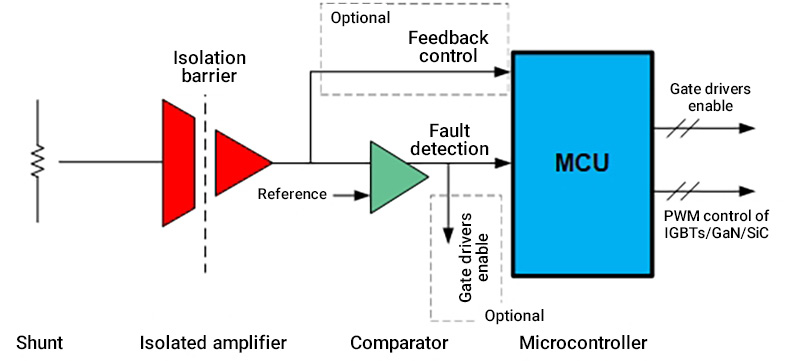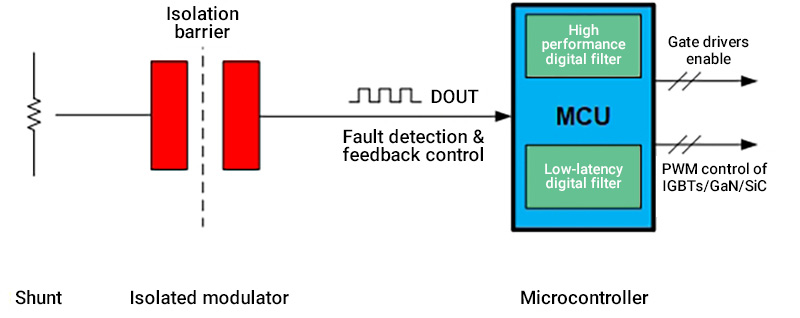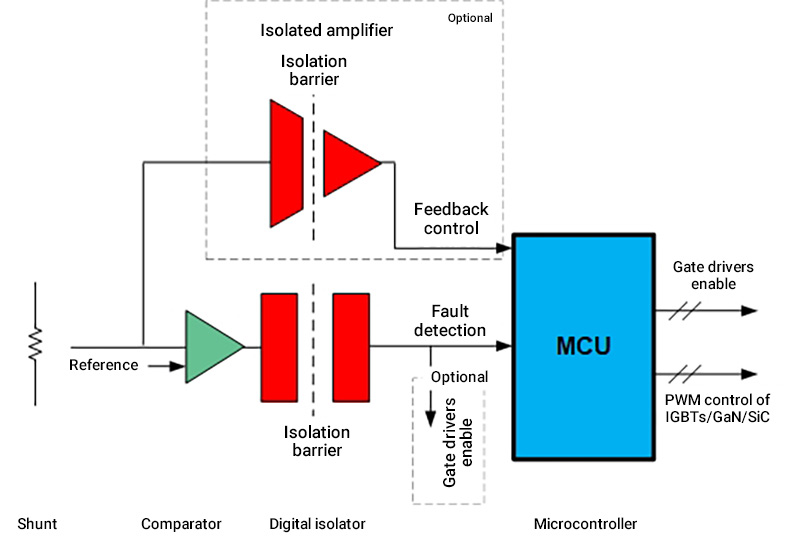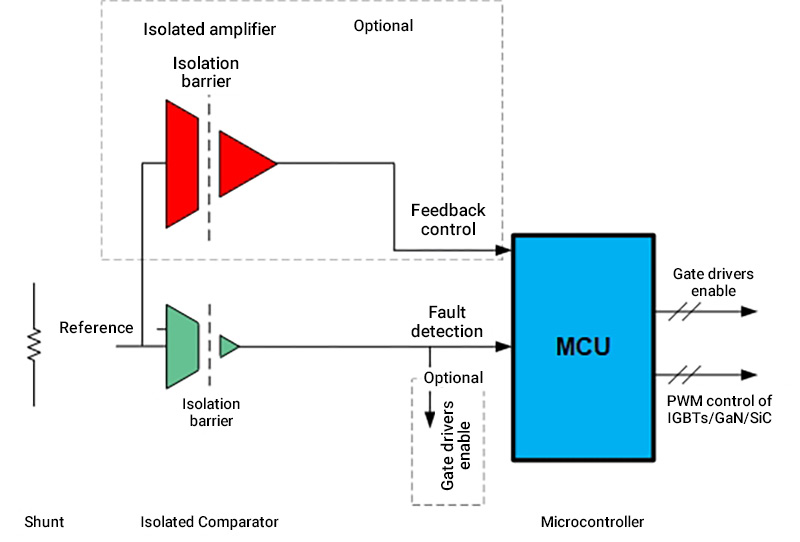SSZT085 april 2022 AMC23C11 , AMC23C12 , AMC23C12-Q1 , AMC23C14
Fault-detection mechanisms are a necessity in high-power industrial systems such as motor drives and solar inverters, as well as automotive systems including electric vehicle (EV) chargers, traction inverters, onboard chargers and DC/DC converters.
Fault detection involves current, voltage and temperature measurements to diagnose any AC power-line fluctuations, mechanical or electrical overloads within the system. Upon the detection of a fault event, the host microcontroller (MCU) performs protective actions such as turning off or modifying the switching characteristics of power transistors or tripping the circuit breakers.
In order to increase efficiency and reduce system size, designers are moving away from insulated-gate bipolar transistors (IGBTs) to wide-bandgap silicon carbide (SiC) and gallium nitride (GaN) switching transistors, which enable faster switching speeds (>100 kHz) with even shorter withstand times (<5 µs).
Protecting power switching transistors from fault conditions begins by detecting overcurrent conditions, using either shunt- or Hall-based solutions. While Hall-based solutions enable a single-module approach, they suffer from poor measurement accuracy, especially over temperature. Other considerations for selecting between shunt- or Hall-based solutions include the isolation specifications and the primary conductor resistance. The primary conductor resistance in a Hall-based solution could lead to the same amount of thermal dissipation as in a shunt-based solution, however, with improvements in shunt technology, shunts now come with much smaller resistances to minimize thermal dissipation, and offer very high accuracy over temperature and lifetime.
Let’s look at several shunt-based methods for fault detection.
| The industry’s smallest isolated comparators | |

|
The AMC23C12 family provides accurate, isolated overcurrent, overvoltage and overtemperature detection. |
Using Isolated Amplifiers
Figure 1 shows a shunt-based overcurrent detection solution with an isolated amplifier and a nonisolated comparator. You can use this same isolated amplifier for feedback control if necessary. The MCU receives the output from the comparator and sends signals to either control the enable pin of the gate driver or alter the pulse-width modulation cycle going to the input of the gate driver.
 Figure 1 Fault Detection with an
Isolated Amplifier and Nonisolated Comparator
Figure 1 Fault Detection with an
Isolated Amplifier and Nonisolated ComparatorA shunt-based approach with an isolated amplifier offers high measurement accuracy for both fault detection and feedback control. The isolated amplifier provides either basic or reinforced isolation.
The isolated amplifier has a propagation delay of 2 to 3 µs, however. Depending on the latency requirements of overcurrent detection, an isolated amplifier-based method may not be fast enough.
Using Isolated Modulators
As shown in Figure 2, it is possible to use an isolated modulator for simultaneous overcurrent detection and feedback control. The isolated data output (DOUT) of an isolated modulator provides a digital bitstream of ones and zeros at a much higher frequency. The time average of this bitstream output is proportional to the analog input voltage, and digital filters inside the MCU reconstruct the measured signal. The MCU can have multiple digital filters running in parallel using the same bitstream output, with one of the digital filters configured for high-accuracy feedback control and another digital filter configured for low-latency overcurrent detection.
 Figure 2 Fault Detection with an
Isolated Modulator
Figure 2 Fault Detection with an
Isolated ModulatorA shunt-based method with an isolated modulator offers even better measurement accuracy for both fault detection and feedback control than an isolated amplifier. The worst-case propagation delay for overcurrent detection can be as low as 1 µs.
Using Standard Comparators and Digital Isolators
Figure 3 shows a standard nonisolated comparator followed by digital isolators for overcurrent detection, with an isolated amplifier or modulator used for feedback control. The worst-case propagation delay for overcurrent detection can be less than 1 µs, depending on the comparators and digital isolators selected. However, a discrete implementation takes up more printed circuit board (PCB) space, and can get expensive for designs requiring higher accuracy.
 Figure 3 Fault Detection with Standard
Comparators and Digital Isolators
Figure 3 Fault Detection with Standard
Comparators and Digital IsolatorsUsing Isolated Comparators
The isolated comparator shown in Figure 4 provides a small, ultra-fast method for overcurrent detection by integrating the functions of a standard comparator and digital isolator. You can use an isolated amplifier or isolated modulator for feedback control.
 Figure 4 Fault Detection with Isolated
Comparators
Figure 4 Fault Detection with Isolated
ComparatorsIsolated comparators such as the AMC23C12 provide a cost-effective, small-size solution for fault detection. These devices have very low latency (<400 ns), which enables ultra-fast overcurrent detection. The AMC23C12 integrates a wide input range (3 V to 27 V) low-dropout regulator for powering the high side, a single window comparator and an isolated galvanic barrier, enabling a reduction in PCB area as high as 50% and a lower bill-of-materials count compared to a discrete implementation. With an adjustable trip threshold and a worst-case accuracy of <3%, the AMC23C12 family serves the growing needs of overcurrent, overvoltage, overtemperature, undervoltage and undercurrent detection.
Table 1 compares various shunt-based fault detection methods.
| Parameter | Isolated amplifiers | Isolated modulators | Discrete implementation | Isolated comparators |
|---|---|---|---|---|
| Latency | Poor | Adequate | Adequate | Excellent |
| Accuracy | Excellent | Excellent | Adequate | Excellent |
| Size | Poor | Adequate | Poor | Excellent |
| Cost | Poor | Poor | Poor | Excellent |
| Isolation | Excellent | Excellent | Excellent | Excellent |
As the demand to improve system resiliency and the adoption of faster switching transistors such as SiC and GaN proliferates, the need for accurate and fast fault detection becomes even more of a priority. The AMC23C12 family of isolated comparators quickly detects various fault events, helping designers develop even more fault-tolerant high-voltage systems.
Additional Resources
- Check out TI’s isolated amplifiers and modulators.
- Read the Analog Design Journal article, "Using Isolated Comparators for Overcurrent and Overvoltage Fault Detection in Electric Motor Drives."